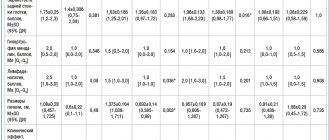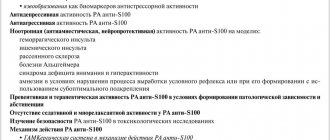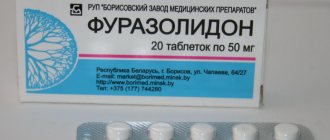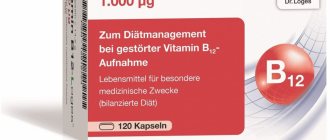Write a review
Reviews: 0
Active ingredients
- Sparfloxacin
Disease class
- Gardeolum and chalazion
- Conjunctivitis
- Blepharoconjunctivitis
- Keratitis
- Purulent endophthalmitis
- Purulent and unspecified otitis media
- Otitis media, unspecified
- Otitis media in bacterial diseases classified elsewhere
- Acute sinusitis
- Pneumonia caused by Streptococcus pneumoniae
- Pneumonia caused by Haemophilus influenzae [Afanasyev-Pfeffer bacillus]
- Pneumonia caused by Klebsiella pneumoniae
- Pneumonia caused by staphylococcus
- Pneumonia caused by other aerobic gram-negative bacteria
- Pneumonia caused by Mycoplasma pneumoniae
- Pneumonia caused by chlamydia
- Other chronic obstructive pulmonary disease
- Skin abscess, boil and carbuncle
- Pyoderma
- Local infection of skin and subcutaneous tissue, unspecified
- Biliary tract disease, unspecified
- Infectious dermatitis
- Other salmonella infections
- Shigelosis
- Respiratory tuberculosis of unspecified localization without mention of bacteriological or histological confirmation
- Leprosy, unspecified
- Gonococcal infection
- Chlamydial lymphogranuloma (venereal)
- Other chlamydial sexually transmitted diseases
- Other diseases caused by chlamydia
- Disease caused by the human immunodeficiency virus [HIV], appearing as infectious and parasitic diseases
- Cystitis
- Urethritis and urethral syndrome
- Inflammatory diseases of the prostate gland
- Salpingitis and oophoritis
Clinical and pharmacological group
- Not indicated. See instructions
Pharmacological action
- Antimicrobial
- Antibacterial
- Bactericidal
Pharmacological group
- Quinolones/fluoroquinolones
Pharmacological properties of the drug Sparflo
cparfloxacin (5-amino-1-cyclopropyl-7-(cis-3,5-dimethyl-1-piperazinyl)-6,8-difluoro-1,4-dihydro-4-oxo-3-quinolinecarboxylic acid) - antimicrobial drug a class of fluoroquinolones, the mechanism of action of which is associated with the inhibition of DNA gyrase, the enzyme responsible for the replication of bacterial DNA. Sparfloxacin has bactericidal activity against most gram-negative and gram-positive microorganisms, chlamydia, mycoplasma, including those relatively resistant to β-lactam antibiotics. Despite the existing resistance to other fluoroquinolones, some microorganisms resistant to them are sensitive to sparfloxacin. Sparfloxacin is active against Mycobacterium tuberculosis , including multi-resistant strains. Sparfloxacin is absorbed relatively slowly from the digestive tract after oral administration, the maximum concentration in the blood serum is reached after 3-6 hours and is 1.2-1.6 mg/l. Absolute bioavailability is 92%. The maximum bactericidal titer of blood serum after taking 400 mg of sparfloxacin is 1.3 ± 0.2 mg/ml. Sparfloxacin binds to plasma proteins, mainly albumin, by 45%. Sparfloxacin has a very large volume of distribution - 3.9±0.8 l/kg. Penetrates well into various organs, tissues and biological fluids (saliva, tear fluid, sweat, nasal secretions, mucous membrane of the bronchi and sinuses, pleural fluid, exudate, etc.), in many cases exceeding the concentration in blood serum. Sparfloxacin penetrates the BBB. It is slowly eliminated from the body, mainly via the extrarenal route. The half-life is 16–30 hours. Patients with moderate and severe renal failure require dose adjustment. Elderly patients and patients with impaired liver function do not require dose adjustment. Food intake does not affect the absorption of the drug and its pharmacokinetics.
Sparfloxacin in the treatment of patients with respiratory infections
Bacterial respiratory infections of the upper and lower respiratory tract occupy an important place among all human infectious diseases [1]. Clinically, they manifest themselves as acute (pharyngitis, tonsillitis, sinusitis, tracheitis, bronchitis, pneumonia), as well as exacerbations of chronic diseases: simple and obstructive bronchitis, bronchiectasis, severe bronchial asthma, etc.
According to various authors, infection causes exacerbation of chronic bronchitis in 50–60% of cases [2]. Pathogens can be gram-positive, gram-negative, anaerobic infections and intracellular pathogens, as well as their associations.
A special place is occupied by viruses, which, by damaging the local defense system, contribute to the colonization of bacteria on the mucous membranes of the upper and lower respiratory tract. Thus, viruses acquire pathogenetic significance in the development of bacterial infection, especially in elderly people with involutive processes in the body, compromised immunity and polymorbidity.
The use of antibacterial drugs when the pathogen is identified is justified from the standpoint of evidence-based medicine [3]. The main role of antibiotic therapy is to eradicate the pathogen associated with the disease.
At the same time, the widespread unjustified use of antibacterial drugs has led to the growth of resistant strains of pathogens, and primarily the pathogen S. Pneumoniae, which is currently resistant to penicillin and macrolides. In this situation, new fluoroquinolones are of particular importance: levofloxacin, sparfloxacin, moxifloxacin, etc. In addition to the high antipneumococcal activity of these drugs, there is evidence of antibacterial activity against atypical pathogens (Mycoplasma pneumoniae, Chlamydia pneumoniae, Legionella pneumophila). In addition, new fluoroquinolones have high activity against Haemophilus influence and Moraxella catarrhalis [6]. However, along with the proven high clinical effectiveness of these drugs, it should be noted the possibility of a number of side effects that may occur during their use: cases of phototoxicity, reactions from the gastrointestinal tract, the central nervous system have been described, isolated cases of prolongation of the QT interval on the ECG have been noted [17]. Since the new fluoroquinolones are highly active antibacterial drugs, it is extremely important to have reliable criteria for confirming the safety of their use.
The purpose of our work is to evaluate the tolerability and therapeutic effectiveness of the new difluoroquinolone sparfloxacin (SPFL) (registered and approved for use in Russia under the name “Sparflo”, produced by Dr. Reddy's Laboratories) in elderly people with multimorbidity, as well as to reduce drug and economic burden.
A specially selected group included 20 patients (9 women and 11 men) with lower and upper respiratory tract infections (severe pneumonia complicated by exudative pleurisy, acute catarrhal and follicular tonsillitis, chronic obstructive bronchitis, severe bronchial asthma). Exacerbation of chronic processes was caused by acute viral infections in 12 patients, hypothermia - in 2 patients. In 6 patients, exacerbation of chronic bronchitis was accompanied by exacerbation of chronic otitis media, tonsillitis and sinusitis. The composition of the observation groups is presented in Table 1. The control group consisted of the same patients who received treatment that was found to be ineffective before being referred to the pulmonology department.
| Observation group data |
The presence of concomitant diseases contributes to the development of infections in older people and complicates antibacterial therapy. The situation is complicated by the presence of three or four diseases in the same patient.
There is literature data (based on randomized multicenter studies) on the results of successful use of SPFL for upper and lower respiratory tract infections, including in people over 65 years of age with concomitant diseases hospitalized due to ineffective previous therapy. The drug was reported to be well tolerated [5].
In the clinic of the Russian Academy of Sciences, patients received sparfloxacin per os in tablets of 200 mg/day for 6–12–15 days, according to indications. To monitor the effect of the drug on the dynamics of disease symptoms and possible negative reactions, patients were offered a questionnaire that was filled out daily.
In the clinic, a clinical examination of the patient by a pulmonologist and an otorhinolaryngologist was carried out 5–10–15 days from the start of treatment with sparfloxacin. Clinical, laboratory, ECG monitoring, including the QT interval, bacteriological sputum, nasal contents, and pharynx were carried out before and after treatment with SPARFLO. X-rays of the chest organs were performed in all patients before and after treatment. In two patients, radiographic examination was supplemented with computed tomography.
Table 2 presents clinical and laboratory data of patients with atypical (mycoplasma or chlamydial) pneumonia before and after treatment with SPARFLO.
Table 2 shows that patients with “atypical” pneumonia are elderly. Febrile temperature, accelerated ESR, and a rod-nuclear shift to the left indicated high intoxication that accompanied the course of the disease. In this case, there was no cough, sputum, chest pain, and no moist rales were heard over the affected area of the lung tissue. The dullness and shortening of the pulmonary sound was due to the presence of free fluid in the pleural area in 2 patients and encysted fluid in 1. While taking SPARFLO, the temperature in patients decreased on the third day to subfebrile and normal. By the end of treatment (days 12–15), blood counts returned to normal. Non-homogeneous infiltration in the lingular segments, middle lobe and effusion in the pleural cavities resolved completely.
Indicators of blood pressure and QT interval on the ECG remained unchanged before and after treatment, no arrhythmias were detected.
Due to the high activity of SPFL against chlamydia and mycoplasmas, its use is justified in the treatment of atypical pneumonia.
Patients with chronic obstructive bronchitis, simple mucopurulent bronchitis, and severe bronchial asthma in the acute stage were combined into a group of 15 people (Table 1). The clinical picture was characterized by normal or subfebrile temperature, cough with mucopurulent sputum in 10 patients, and increased shortness of breath during exercise. In patients with bronchial asthma, distant wheezing occurred, nocturnal episodes of full-blown asthma attacks appeared, peak flow readings decreased to 200–300 l/min, and the need for bronchodilators increased. All patients underwent nasopharyngolaryngoscopy, catarrhal processes in the nasopharynx were detected; exacerbation of chronic tonsillitis (2 patients), otitis media (2 patients), sinusitis (2 patients). ECG data, blood pressure, and pulse rate corresponded to the exacerbation and concomitant pathology. After treatment with SPFL, the QT interval did not change. Before the start of therapy, sputum and contents of the nose and pharynx were collected for bacteriological examination and sensitivity determination. The studies were repeated after the end of treatment. The species composition of microorganisms isolated from sputum before and after SPARFLO treatment is presented in Table 3.
Complete eradication of the pathogen was observed in 6 out of 10 patients; eradication and change of microorganism in 2. The clinical effect occurred in all patients.
Eradication of the pathogen from the nose and pharynx was determined in 13 patients (Table 4). A higher elimination rate than from sputum is possibly due to the predominance of gram-negative flora in the development of the disease in the upper respiratory tract and its high sensitivity to SPARFLO.
| Species composition of microorganisms from throat and nasal sputum |
Sensitivity to sparfloxacin was superior to ciprofloxacin and ofloxacin in vitro.
Tolerability of sparfloxacin during administration (200 mg/day for 6–12–15 days, according to the disease) was good. Side effects from the gastrointestinal tract (flatulence, stool retention) were observed in 1 patient. After completing the 12-day course, the stool returned to normal. The history included evidence of chronic colitis, pancreatitis, and dysbacteriosis.
Kidney and liver function were monitored in all patients.
Before prescribing sparfloxacin and 15 days after starting to take this drug, a biochemical blood test was carried out: determination of enzyme activity (aspartic and alanine transaminases, alkaline phosphatase, γ-glutamyl transpeptidase), urea bilirubin, creatinine. The results of biochemical parameters are presented in Table 5.
The results obtained were subjected to statistical analysis, which did not reveal significant differences in the activity of the enzymes aspartate aminotransferase and alanine aminotransferase, alkaline phosphatase, γ-glutamyl transpeptidase, as well as the content of bilirubin (total, bound, free) in patients treated with spartafloxacin compared with those who had place before treatment with this drug. There were also no changes in the concentrations of creatinine and urea in the examined groups of patients. In addition, no negative dynamics were noted during biochemical examination in patients who had increased values of the analyzed biochemical parameters before treatment due to concomitant diseases.
Thus, in patient N, who was undergoing treatment with sparfloxacin for exacerbation of chronic purulent obstructive bronchitis with concomitant chronic interstitial nephritis, before treatment with this drug, the blood urea and creatinine levels had the following values, respectively: 10.2 mmol/l and 180 µmol/ l; after treatment - 10.2 mmol/l and 163 µmol/l; in 2 other patients, also due to concomitant diseases, a biochemical blood test revealed an increase in the activity of alkaline phosphatase and the content of urea and creatinine before treatment with sparfloxacin; after completing a course of treatment with this drug for the underlying disease, these indicators did not exceed normal values.
Based on the above, we can draw the following conclusion. Sparfloxacin (trade name SPARFLO, Dr. Reddy's Laboratories) at a dose of 200 mg/day for 6–12–15 days is well tolerated by elderly patients with pathology of the upper and lower respiratory tract, aggravated by concomitant diseases. There was no prolongation of the QT interval or fatal arrhythmia; no hepatoxic effects or significant deviations in biochemical tests characterizing renal function were detected; The patients did not report (according to the questionnaire) disturbances from the central nervous system (sleep, headaches); passing adverse events from the gastrointestinal tract were noted.
SPARFLO is a highly effective drug in the group of patients with pneumonia, chronic obstructive bronchitis, and infectious diseases of the ENT organs that we studied, which is confirmed by clinical, laboratory and microbiological data. The therapeutic effect is due to the high sensitivity of a wide range of microorganisms to the drug and optimal pharmacokinetics.
A convenient dosing regimen (once a day) creates high compliance, and a short course of treatment and a moderate dose of the drug can reduce the drug burden and reduce the cost of treatment.
For questions regarding literature, please contact the editor.
V. P. Dubynina , Candidate of Medical Sciences, Corresponding Member of the Russian Academy of Sciences T. G. Zokina, N. I. Pochkina L. N. Fitenko , Candidate of Medical Sciences Central Clinical Hospital of the Russian Academy of Sciences, Dr. Reddis company, Moscow
Indications for use of the drug Sparflo
Uncomplicated and complicated infections caused by pathogens sensitive to the drug:
- respiratory infections: pneumonia, exacerbation of COPD, otitis media, sinusitis;
- gastrointestinal infections: salmonellosis, shigellosis;
- sexually transmitted diseases: gonorrhea, chlamydia;
- infections of the genitourinary system: urethritis, cystitis, pyelitis;
- infections of the skin and soft tissues: infected wounds, abscesses, pyoderma, furunculosis, infectious dermatitis;
- surgical infections.
Contraindications
The antibiotic is contraindicated for use:
- for epilepsy ;
- patients with a long QT interval and other heart diseases that contribute to the development of cardiac arrhythmia ;
- for hypokalemia , bradycardia , chronic heart failure, atrial fibrillation;
- patients with glucose-6-phosphate dehydrogenase ;
- during lactation and pregnancy;
- under the age of 18 and in adolescence;
- with severe renal failure ;
- if allergic to this group of antibiotics.
Drug interactions Sparflo
The simultaneous use of Sparflo and antacid drugs that contain aluminum or magnesium hydroxide, as well as ferrous sulfate and sucralfate, reduces the absorption of Sparflo. In this regard, Sparflo should be taken 1–2 hours before or at least 4 hours after taking these drugs. Unlike other fluoroquinolones, Sparflo has virtually no effect on the pharmacokinetics of theophylline. Sparflo increases the concentration of digoxin in the blood serum; careful monitoring is required when taking these drugs simultaneously. It is not recommended to use Sparflo simultaneously with drugs that can cause prolongation of the QT (terfenadine, astemizole, erythromycin, class Ia and III antiarrhythmic drugs). Cisapride accelerates the absorption of sparfloxacin, but does not affect its bioavailability. Cimetidine does not affect the distribution of sparfloxacin.
Similar drugs:
- Augmentin Oral tablets
- Tea tree DN Ointment for external use
- Augmentin Powder for suspension for oral administration
- Bactrim Oral suspension
- Dioxydin Mouth rinse solution
- Pancef Oral tablets
- Nifuroxazide (Nifuroxazide) Oral tablets
- Cifran OD Oral tablets
- Pancef Granules for the preparation of suspension for oral administration
- Augmentin ES Powder for oral solution
** The Drug Directory is intended for informational purposes only. For more complete information, please refer to the manufacturer's instructions. Do not self-medicate; Before you start using Sparflo, you should consult a doctor. EUROLAB is not responsible for the consequences caused by the use of information posted on the portal. Any information on the site does not replace medical advice and cannot serve as a guarantee of the positive effect of the drug.
Are you interested in Sparflo? Do you want to know more detailed information or do you need a doctor's examination? Or do you need an inspection? You can make an appointment with a doctor - the Euro lab is always at your service! The best doctors will examine you, advise you, provide the necessary assistance and make a diagnosis. You can also call a doctor at home . Euro lab clinic is open for you around the clock.
** Attention! The information presented in this medication guide is intended for medical professionals and should not be used as a basis for self-medication. The description of the drug Sparflo is provided for informational purposes only and is not intended for prescribing treatment without the participation of a doctor. Patients need to consult a specialist!
If you are interested in any other drugs and medications, their descriptions and instructions for use, information about the composition and form of release, indications for use and side effects, methods of use, prices and reviews of drugs, or you have any other questions and suggestions - write to us, we will definitely try to help you.
Sparfloxacin, instructions for use (Method and dosage)
Sparfloxacin is prescribed orally. The tablets are not divided, not chewed, washed down with a sufficient amount of water. The duration of treatment depends on the type of disease and severity of the disease, on the causative agent of the disease.
Medicine for pneumonia , bronchitis and sinusitis is taken 0.4 grams on the first day, and 0.2 grams per day for the next 10 days.
For the treatment of urinary tract infections, 0.2 grams are used on the first day of treatment, and 0.1 grams once a day for another 10-14 days.
Gonorrheal urethritis is treated with a single dose of 0.2 g of medication.
Non-gonococcal urethritis is treated by taking 0.2 g of the substance on the first day and 0.1 g, once a day for 6 days.





